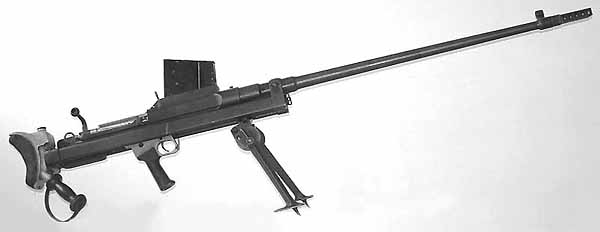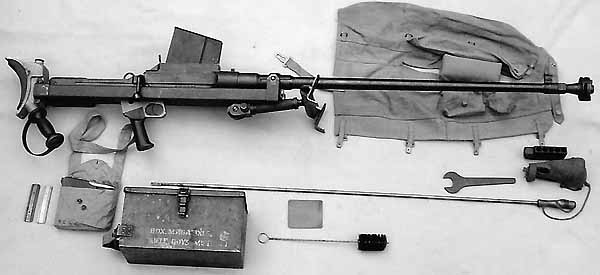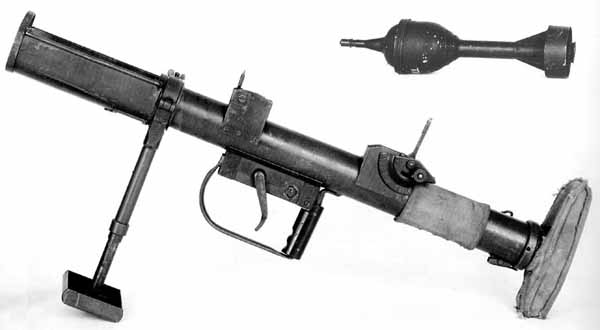INFANTRY ANTI-TANK WEAPONS IN AUSTRALIAN SERVICE
IN THE 1939 - 1945 WAR
by
Don Davie
A race began in the 1914-1918 War between designers seeking to develop improved tank armour, armament and performance, and those essaying to devise effective anti-tank weapons. The race continued during the between-war years and into the Second World War, the outcome varying from time to time but always exercising a powerful influence upon tactical doctrine.
The employment of armour was a major feature of the campaigns against Italian and German forces, in which the 2nd Australian Imperial Force (2 AIF) participated in the Middle East in 1940-1942. The terrain in most areas in which the 6th, 7th and 9th Australian Infantry Divisions fought was eminently well suited for tank warfare and both the Allied and Axis forces made good use of armour. At the same time, both sides sought to produce anti-tank weapons capable of defeating the best of the enemy’s armour.
Japan’s entry into hostilities against the Allied Powers in December 1941 saw the return of the Australian divisions in the Middle East to Australia, and their commitment with other Australian and United States formations to New Guinea and adjacent islands to the north. Tank warfare was not a notable feature of operations in the rugged terrain and tropical rainforests of the South-west Pacific Area (SWPA). Japanese armour was not encountered in significant numbers in the theatre and tanks and anti-tank weapons were employed to only a limited extent by the Allied forces.
Anti-tank weapons issued in the Australian Military Forces in World War II were predominantly British and fell into two categories – those employed by specialist artillery units and those provided to infantry battalions.
Anti-tank artillery units were equipped initially with the 2-pounder anti-tank gun of 37 mm calibre. This weapon was soon found to be ineffective as the armour and performance of German tanks were improved, and anti-tank regiments then received the far more effective 6-pounder (57 mm calibre) anti-tank gun. In addition, the 25-pounder (88 mm calibre) gun-howitzer of field regiments had an anti-tank capability, and anti-aircraft guns – the Bofors 40 mm light anti-aircraft gun and the 3.7 inch (84 mm) heavy anti-aircraft gun – could be used in the anti-tank role in an emergency.
Anti-tank weapons issued to rifle companies of infantry battalions were designed to be carried by the soldier, and were of much shorter range and less effect than anti-tank artillery. As with anti-tank artillery, they were capable of being employed against other targets, such as motor transport and defensive strong points.
The first anti-tank weapon issued to 2 AIF infantry units, the Boys (or Boyes) .55 inch (13.97 mm) calibre anti-tank rifle, was designed by the British Small Arms Committee and was named for a Committee member, Captain Boys, Assistant Superintendent of Design at the Royal Small Arms Factory, Enfield. The Boys was manufactured in England by Birmingham Small Arms (BSA), and the first sample was delivered by BSA in January 1936. Production in England continued until August 1943. The Boys was also manufactured in Canada and the United States following the outbreak of the 1939-1945 War.

The Boys was a bolt-action weapon of conventional appearance and operation for an anti-tank rifle, and of moderate calibre in comparison with other anti-tank rifles such as the Swedish Lahti of 20 mm calibre.

The Boys Mk. 1 and Mk. 1* rifles had a mass of 36 pounds (16.3 kg) and a removable magazine with a capacity of 5 rounds. The Boys cartridge was unique among British military cartridges in that it had a belted case. The cartridge had limited penetration capability and rapid improvements in the thickness and quality of German tank armour soon forced the British to look for a more effective anti-tank weapon for infantry battalions.
Although a completely different concept from the Boys rifle, the adopted replacement was another British design: the Projector, Infantry, Anti-tank (PIAT). The PIAT was a single shot weapon with a mass of 35 pounds (16 kg). It discharged a shaped-charge bomb of about 3.5 inches (90 mm) diameter and with a mass of 2.5 pounds (1.16 kg). The weapon was notorious for the force of about 200 pounds (90 kg) required to overcome the inertia of the massive spigot spring in manual cocking. The spigot was withdrawn into the tubular body of the weapon on cocking, which allowed the bomb to be placed in the trough at the front of the weapon. The PIAT was designed to self–cock after discharge of the first bomb, however this did not always eventuate! Nominal maximum range was 350 yards (320 metres) but that was for the destruction of strong points or ‘housebreaking’ only. Maximum effective range as an anti-tank weapon was in the order of about 100 to 115 yards (90 to 105 metres).

On being fired, an operation requiring four fingers on the large trigger and the full strength of the hand, the PIAT lurched forward and then recoiled back violently. If the weapon was not held firmly on firing, residual recoil was at times insufficient to re-cock the piece and this then had to be done manually, a difficult and possibly dangerous procedure in the face of the enemy.
The PIAT was renamed the PITA, for Projector, Infantry, Tank Attack, in late 1943 or early 1944 and Anti-Tank Regiments became Tank Attack Regiments. This piece of psychological double-talk was intended to inculcate a spirit of aggression but whether called the PIAT or PITA the weapon was cumbersome and required a combination of strength and know-how to operate. Nevertheless, it provided anti-tank capability within the rifle company and accounted for numbers of enemy tanks in the African and European campaigns.
The 2.36 inch (61.95 mm) rocket launcher (commonly known as the Bazooka) was developed in the United States and was first used by the US Army against German forces in North Africa in November 1942. Primarily an anti-tank weapon, it was also effective against defensive positions within its fairly short range. The weapon was issued to Australian units in the latter stages of the campaign in the SWPA.
The first model consisted of a steel tube about 5 feet (1.5 m) in length and open at both ends. The weapon was equipped with a hand-grip, an electrical trigger mechanism, shoulder rest and simple sights, and had a mass of 14.5 pounds (6.6 kg). Initially, the trigger mechanism relied upon small torch batteries but these were later replaced by an impulse generator. A rocket launcher team usually comprised a firer and a loader. The weapon was recoilless however the back-blast from the rear of the launcher on firing prohibited its use in confined spaces. The Bazooka was later made in two sections to facilitate carrying, and an aluminium model was developed in 1945.

The 2.36 inch rocket launcher fired a rocket with a length of 19 inches (482 mm) and a mass of 3.5 pounds (1.6 kg). The rocket contained 8 ounces (226.8 g) of pentolite explosive in the form of a shaped charge, and some United States sources state that it was capable of penetrating 5 inches (127 mm) of armour plate at 300 yards (275 m). Other sources put penetration at 4 inches (100 mm). While the low velocity of about 300 feet per second (92 m/sec) limited the range and accuracy of the weapon, it was a major improvement on the anti-tank weapons previously issued to Australian infantry battalions.
Japan capitulated to the Allied Powers on 15 August 1945, before Australian formations could be committed to areas such as Java where the Japanese could have employed tanks and other armoured fighting vehicles against an invading Allied force. Japanese forces in the Asia-Pacific theatres of operation lacked tanks equivalent to Allied and German heavy armour, and the 2.36 inch rocket launcher should have proved effective if the projected invasions of Japanese-held territory had proceeded.
BIBLIOGRAPHY
Hogg, I. V. & J. Weeks, Military Small Arms of the 20th Century (6th Edition), London, Arms and Armour Press, 1991.
Myatt, F., Modern Small Arms, London, Salamander Books Ltd., 1978.
Skennerton, I. D., British Small Arms of World War 2, Margate, I. D. Skennerton, 1988.